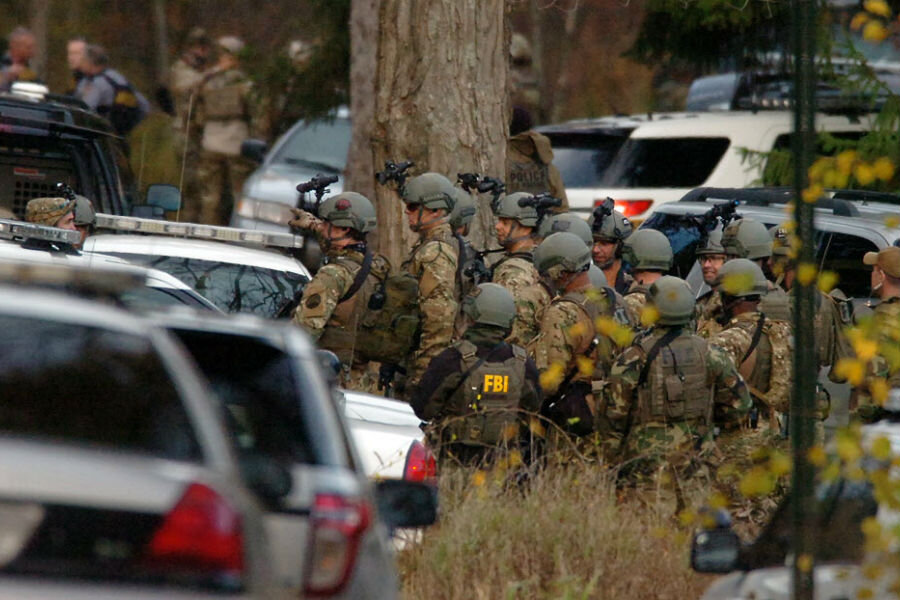Eric Frein sightings: How 'wilderness ninja' has outfoxed 1,000 cops
Loading...
| Atlanta
Two fresh sightings of alleged sniper Eric Frein have resulted in more closed public schools in northern Pennsylvania and a shift in a massive manhunt to near where Mr. Frein went to high school – and where he was a member of the high school rifle team.
The pressing question of how a single man has outmaneuvered 1,000 trained law enforcement officers in the Pocono Mountains for over five weeks suggests that Frein has used a home-field advantage, long-term planning, and survival skills to resemble a “wilderness ninja,” a term some use to describe a rare breed of native scouts who can, in essence, morph into shadows.
But while true native scouts are bulwarks for good, Frein has “gone to the dark side,” says Shane Hobel, the founder of the Mountain Scout Survival School in New York’s Hudson Valley.
“This guy is on a totally different parallel [than a native scout] but it is a parallel,” says Mr. Hobel. “That makes him a dangerous individual, and the fact that he’s got sniper capability makes it even more dangerous.”
A self-taught survivalist and crack rifle shot, Frein is alleged to have killed one state trooper and wounded another in a brazen midnight ambush on a rural police barracks in Blooming Grove, Pa., on Sept. 12.
Tom Brown, the legendary American tracker and founder of the Tracker School in Manahawkin, N.J., says that Frein likely planned the attack and escape for years. That’s corroborated, says Mr. Brown, by stories about Frein disappearing from work for weeks at a time, likely to prepare food caches and find hidden shelters. The fact that searchers have failed to spot Frein with heat-sensitive scanners suggests he may be hiding in caves.
After five weeks of searching, police have at times come titillatingly close to Frein, spotting him on several occasions and finding several camp spots, including one with a rifle, ammunition, and a diary that recounts the shooting in cold-blooded terms.
Police insist they’re close to capturing Frein, believing that he is increasingly feeling stressed and cornered.
The most recent possible sightings – including Monday near a post office in Swiftwater, Pa., and three days earlier near Pocono Mountain East High School – seem to corroborate those observations. Those sightings suggest that Frein “is going to be making mistakes,” says Mr. Brown.
Hampering the search, he adds, is that police have to be “very, very cautious. When you’re dealing with a man with sniper capabilities, a tracker is torn between looking at tracks on the ground and then worry that someone can drop you at 300 yards, even 500 yards. Then you don’t know if his place is going to be tripwired. It’s nerve wracking.”
But the failure so far of the police and military-style manhunt to flush Frein, and given repeated failures to close in on him after spotting him, suggests to some American trackers that there are deeper flaws with the police approach.
Too few of the searchers in pictures have “mud on their knees,” observes Brown, suggesting that officers aren’t spending enough time crawling through underbrush and through small caves.
In that light, there’s likely increasing pressure on police to call in civilian trackers like Brown, who has participated in dozens of search operations, including ones where he’s been shot and stabbed.
Search crews appear to have waded out of their depth with "guys flown in from somewhere else to go onto Frein's playing field," says Hobel. “At the same time, I’ve got to support the searchers – they’re out there in the landscape, against an enemy they’re unfamiliar with, moving in a way they’re not trained, and basically going into guerrilla warfare.”
Given his penchant for war games and authentic Serbian Army fatigues, Frein, whom authorities say has a deadly beef with police, is clearly skilled, highly motivated, and fueled by a dark anti-police philosophy.
It's still unclear what drives Frein's anti-government and anti-police philosophy, but his fascination with the Serb Army could offer clues. Much like the former Confederacy in the US, Serbs have a deep sense of a defining "lost cause" in their culture, epitomized by the Serbian army's failure to stanch the Ottoman Empire's advance into Europe at the Battle of Kosovo in 1389. Atrocities suffered by Serbs at the hands of Croatian fascists and German Gestapo in World War II, largely ignored by the West, only fueled a national sense of grievance.
But referencing Christopher Knight, the so-called North Pond Hermit, who lived for 27 years in the backwoods of Maine, surviving mainly on pilfered goods before his arrest in 2013, Brown notes that that hermit “wasn’t a survivalist, he was just a thief in the woods – and that’s what this guy is going to become. Unfortunately, if he’s not mentally stable, somebody innocent is going to get themselves hurt.”





